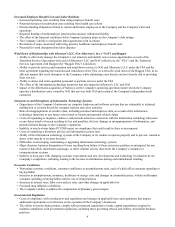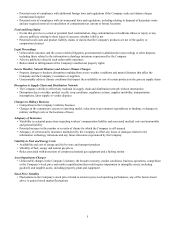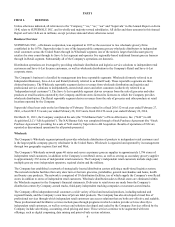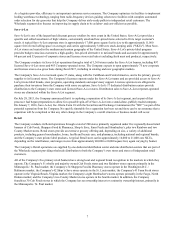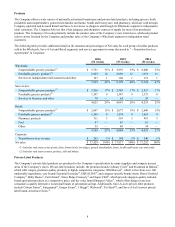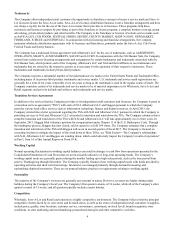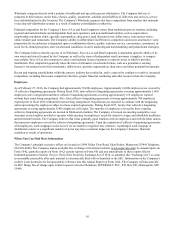Albertsons 2016 Annual Report Download - page 16
Download and view the complete annual report
Please find page 16 of the 2016 Albertsons annual report below. You can navigate through the pages in the report by either clicking on the pages listed below, or by using the keyword search tool below to find specific information within the annual report.14
The results and impact of the Company’s announcement that it is exploring a separation of its Save-A-Lot segment and
that it has begun preparations to allow for a possible spin-off of Save-A-Lot into a stand-alone, publicly traded company
are uncertain and cannot be determined.
On July 28, 2015, the Company announced that it is exploring a separation of its Save-A-Lot segment, and that as part of that
process it has begun preparations to allow for a possible spin-off of Save-A-Lot into a stand-alone, publicly traded company,
including engaging financial and legal advisors. On January 7, 2016, Save-A-Lot, Inc. filed a Form 10 with the SEC as part of
the ongoing exploration of a potential separation from the Company. No specific timetable for a separation has been set and
there can be no assurance that a separation will be completed or that any other change in the Company’s overall structure or
business model will occur. Any transaction or other change in the Company’s overall structure or business model that is
ultimately completed may not deliver the anticipated benefits or enhance shareholder value. The Company has, and expects to
continue to, incur expenses associated with preparing for a possible spin-off, and the process of considering, preparing for and
implementing such a course of action may distract the Company’s management team from their day-to-day responsibilities and
make it more difficult to retain employees, and may otherwise be disruptive to the Company’s business operations. Any of these
risks or uncertainties could adversely affect the Company’s business, financial condition, results of operations or cash flows.
The Company’s Wholesale and Save-A-Lot licensee distribution business models present a number of risks.
The Company’s success relies in part on the financial success and cooperation of its independent retail customers and Save-A-
Lot licensees. These independent retail customers and licensees manage their businesses independently, and therefore are
responsible for the day-to-day operation of their stores. The revenues the Company realizes from these independent retail
customers and licensees are largely dependent on their ability to maintain and grow their sales. They may not experience sales
growth or achieve an acceptable level of sales or profitability, and the Company’s revenues and gross margins could be
negatively affected as a result. If sales trends or profitability worsen for independent retail customers or licensees, their
financial results may deteriorate, which could result in, among other things, store closures or delayed or reduced payments to
the Company and could adversely impact the Company’s ability to grow its Wholesale or Save-A-Lot licensee business.
Additionally, if licensees do not successfully operate stores in a manner consistent with the Company’s required standards, the
Save-A-Lot brand’s image and reputation could be harmed, which in turn could hurt the Company’s business and operating
results.
The Company may not be able to grow or maintain its levels of identical store sales.
The Company has experienced both positive and negative identical store sales in recent periods. If the Company’s identical
store sales decline or fail to meet market expectations, the price of the Company’s stock could decline. A variety of factors
affect identical store sales and profitability, including consumer tastes, competition, current economic conditions, pricing,
inflation, deflation and weather conditions, and many of these factors are beyond our control and can be difficult to predict in
advance. These factors may cause the Company’s identical store sales results to be materially lower than recent periods, which
could harm the Company’s results of operations and result in a decline in the price of the Company’s stock.
The Company’s inability to maintain or increase its operating margins could adversely affect its results of operations
and the price of the Company’s stock.
The Company may not be able to maintain or increase its operating margins. If the Company is not able to continue to capture
scale efficiencies, improve its systems and discipline and enhance its merchandise offerings, the Company may not be able to
achieve its goals with respect to operating margins. In addition, if the Company does not continuously refine and improve its
various ordering, tracking and allocation systems, the Company may not be able to increase sales and reduce inventory
shrinkage. As a result, the Company’s operating margins may stagnate or decline, which could adversely affect the price of the
Company’s stock.
The Company has substantial indebtedness that could increase the Company’s borrowing costs and decrease the
Company’s financial and operational flexibility.
The Company has, and expects to continue to have, a substantial amount of debt. The Company’s indebtedness may increase
the Company’s borrowing costs and decrease the Company’s business flexibility, making it more vulnerable to adverse
economic conditions. For example, substantial levels of debt could:
• require the Company to use a substantial portion of its cash flow from operations for the payment of principal and interest
on its indebtedness, thereby reducing the availability of cash flow to fund working capital, growth opportunities, capital
expenditures, acquisitions and for other purposes;


